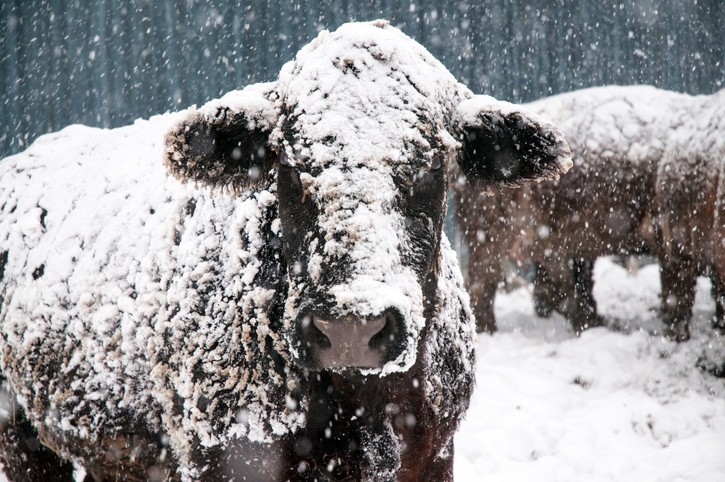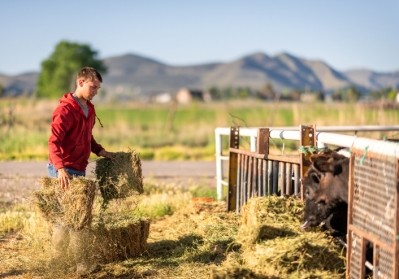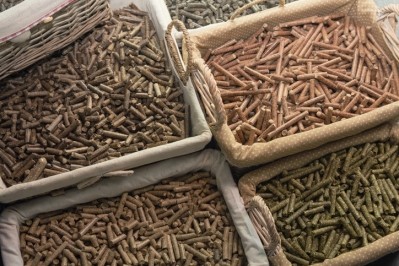Varying feed pellet size, binder use may support cattle feed intake, production

A team of researchers from the University of Saskatchewan examined the influence of pellet size and binding agents on ruminal fermentation and digestibility for cows facing outdoor grazing in winter.
The study was published in the journal, Applied Animal Science.
“The objective of this study was to determine whether pellet size and inclusion of pellet binding agents affect DMI, ruminal fermentation, and total-tract digestibility and to assess cow performance and wastage of pellets when fed under winter grazing conditions,” the researchers said.
In the first feeding trial, researchers reported that altering pellet size and binder use did not alter the intake of forage or pellets or influence ruminal pH. However, cattle on the large pellet with binder diet (LP-B+) had more ruminal acetate than those on the small pellet with binder diet (SP-B+), while cattle on the large pellet with no binder diet (LP-B-) had more propionate than cows on the LP-B+ feed.
Cows receiving feeds with a binding agent had a higher molar proportion of butyrate than cows that had a feed without binders, they said. “Apparent total-tract digestibility was not affected.”
In the second feeding trial, no differences were found among cows regardless if they received a diet with small or large pellets or with or without binder supplementation, they said.
“Pellet size and binder inclusion do not affect forage or pellet intake, apparent total-tract digestibility, or cow performance,” the researchers said. “However, pellet size and binder inclusion may modulate ruminal fermentation.”
Why use feed pellets with cattle?
Cattle producers in Canada have adopted a winter-feeding system to reduce costs, the researchers said. The grazing system allows for the use of more by-products like straw and chaff but limits costs from “harvest, transportation and feed delivery.”
However, as the types of byproducts used tend to be low in quality, nutritional supplementation is needed to meet cattle needs, they said. Additional feed tends to be delivered on the group, which may increase the amount lost.
Improving the durability of pellets would reduce the potential for damage from handling and waste, along with better maintaining the “original physical characteristics” of the feed, they said. Adding, “It may be possible that increasing the size of the pellet may promote consumption and reduce feeding losses; however, this suggestion has not been confirmed.”
Do binding agents improve high-fiber, high-lipid feed pellets?
Feeding pelleted byproducts from grain and oilseed production has been one way to supplement cattle diets as pelleted feeds lower the number of ingredients producers have to manage, the researchers said. But, the process also may limit the digestibility of high-fiber ingredients and elements that are high in fiber or lipids may reduce feed quality.
“Understanding how pellet durability, the ability to withstand handling without generating excessive amounts of fines (Behnke, 2001; Hemmingsen et al., 2008), affects the consumption of the delivered nutrients is important from a nutritional and economical point of view,” they said. “High-fiber- and high-lipid-containing pellets commonly result in pellets with a low durability.”
Feed mills manufacture pelleted feeds to mimic the energy density of barley grain using lipids like off-grade canola meal while ingredients like oat hulls are employed to keep costs low, they said.
“One strategy to improve pellet durability is to incorporate the use of binding agents,” the researchers said. “However, there is a lack of data for whether binding agents improve the physical quality of pellets when they contain high-fiber and high-lipid by-products.”
Feeding trial details
In the first feeding trial, eight cannulated heifers received one of four pelleted diets in a 4x4 Latin square arrangement. Cows were on a diet for an 18-day period before being switched to another trial feed. Each period had 15 days of adaptation and three days of collection.
The diets included small pellets – 5.7cm – or large pellets – 6.35cm – and either included a commercial binding agent (B+) or without the binding agent (B-), the researchers said. Pellets included wheat screenings, wheat, pea screenings, oat hulls, off-grade canola, pea starch, molasses and salt.
In addition to the pellets, cows received a partial mixed ration, they added.
Cow body weight was recorded at the start and end of each feeding period, and the feed provided and refused was noted daily, the researchers said. Dry matter intake (DMI) was calculated, ruminal pH was measured and ruminal digesta and manure samples were collected for analysis.
In the second feeding trial, a barley field was grown and harvested to generate a straw-chaff (STCH) crop residue and provide six paddocks for winter grazing, they said. The three diets examined included the STCH supplemented with small pellets with or without a binder (SP-B+ or SP-B-) or large pellets with a binder (LP-B+) along with a commercial mineral supplement.
The two feeding periods ran for 43 days and 37 days and included 30 cows, they added.
Cow body weight (BW) and body condition score (BCS) was recorded at the start and end of the feeding periods, the researchers said. Pellet durability was recorded at the start of the trial and pellets were ground fed during the trial.
Forage intake and DMI were estimated and the average daily STCH intake was determined, they said. Pellet intake was noted at the start, middle and end of the trial.
Results
The feeding trials were intended to examine how the change in pellet size or use of binders altered pellet durability on ruminal fermentation and digestibility along with pellet intake during grazing, the researchers said.
“Pellet size and inclusion of binding agents did not affect pellet or forage DMI,” they said. “The use of binding agents during pelleting interacted with pellet size to modulate ruminal fermentation, but the response was not large enough to translate into improvements for cow performance in an extensive winter-feeding system, perhaps due to the high pellet utilization in the present study.”
Overall, adding the binding agents and pea starch to pellets did not significantly improve pellet durability, they added.
In the first feeding trial, no effects were found related to pellet size on DMI, average daily gain (ADG) or the gain to feed ratio (G:F), the researchers said. And there was no interaction noted between pellet size and use of binders.
Cow intake of the partial mixed ration and the pellets did not differ, they said. However, ADG and the G:F were higher for cows receiving pellets with the binding ingredients.
Cows on the LP-B+ diet had a greater molar proportion of acetate, while cows on the LP-B- feed had more ruminal propionate than cows receiving a diet with a binding agent, they said. Cows getting diets with a binder had higher ruminal butyrate concentrations.
“The changes in the molar proportions of acetate, propionate, and butyrate indicate that pellet size and inclusion of binders during the pelleting process may modulate rumen fermentation patterns,” the researchers said. Ruminal pH and total tract dry matter digestibility did not vary based on diet, nor did total tract organic matter, crude protein, non-detergent fiber, ADF, starch or fat.
In the second feeding trial, the large pellets with binding ingredients tended to be slightly more durable, the researchers said. Cows on all diets had similar pellet and forage intake rates.
“Although initial BW differed among treatments, final BW did not differ nor did BW change,” they said. “In addition, rib fat, rib fat change, rump fat, and rump fat change were not different.”
“These results suggest that pellets differing in size or inclusion of a pellet binder may not affect performance of wintering cows grazing primarily barley straw–chaff residues,” they said. “Given that nutrient composition and DMI were similar among treatments, it would be expected that cow performance would also be similar.”
Source: Applied Animal Science
Title: Effects of pellet size and inclusion of binding agents on ruminal fermentation and total-tract digestibility of beef heifers, and cow performance under winter grazing conditions
Authors: K. Wood, D. Damiran, J. Smillie, H. Lardner, K. Larson, G. Penner
DOI: doi.org/10.15232/aas.2018-01832













